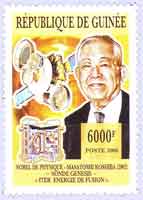.
Masatoshi Koshiba

Masatoshi Koshiba ( Koshiba Masatoshi, born on September 19, 1926 in Toyohashi, Aichi Prefecture -) is a Japanese physicist who won the Nobel Prize in Physics in 2002.
Dr. Koshiba graduated from University of Tokyo, School of Science in 1951. He received a Ph.D in physics at the University of Rochester, New York, in 1955. In 2002 he won Nobel Prize in Physics "for pioneering contributions to astrophysics, in particular for the detection of cosmic neutrinos".
He is now Senior Counselor of ICEPP and Emeritus Professor of University of Tokyo.
Koshiba earned a Ph.D. from the University of Rochester in New York in 1955. He then joined the University of Tokyo, where he became professor in 1960 and emeritus professor in 1987. From 1987 to 1997 Koshiba taught at Tokai University.
Koshiba's award-winning work centred on neutrinos, subatomic particles that had long perplexed scientists. Since the 1920s it had been suspected that the Sun shines because of nuclear fusion reactions that transform hydrogen into helium and release energy. Later, theoretical calculations indicated that countless neutrinos must be released in these reactions and, consequently, that Earth must be exposed to a constant flood of solar neutrinos. Because neutrinos interact weakly with matter, however, only one in a trillion is stopped on its way to Earth. Neutrinos thus developed a reputation as being undetectable.
In the 1980s Koshiba, drawing on the work done by Raymond Davis Jr, constructed an underground neutrino detector in a zinc mine in Japan. Called Kamiokande II, it was an enormous water tank surrounded by electronic detectors to sense flashes of light produced when neutrinos interacted with atomic nuclei in water molecules. Koshiba was able to confirm Davis's results—that the Sun produces neutrinos and that fewer neutrinos were found than had been expected (a deficit that became known as the solar neutrino problem). In 1987 Kamiokande also detected neutrinos from a supernova explosion outside the Milky Way. After building a larger, more sensitive detector named Super-Kamiokande, which became operational in 1996, Koshiba found strong evidence for what scientists had already suspected—that neutrinos, of which three types are known, change from one type into another in flight.
Prof. Koshiba is a member of the Board of Sponsors of The Bulletin of the Atomic Scientists[1].
Links
Retrieved from "http://en.wikipedia.org/"
All text is available under the terms of the GNU Free Documentation License

